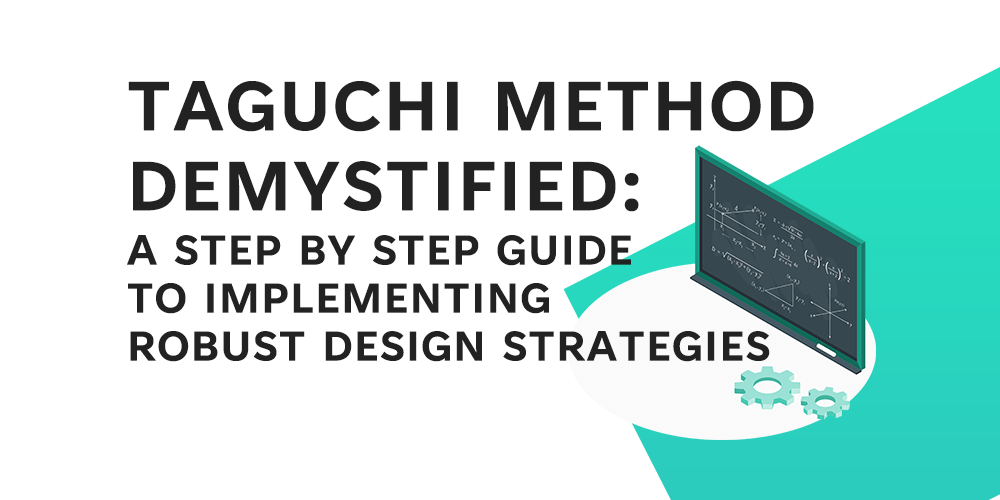Do you have product designs that fall short of meeting customer expectations? Do you want to increase the quality and dependability of your products while lowering your costs? If so, you’ve come to the right place! In this blog post, we’ll unravel the mystery of the Taguchi Method, a tried-and-true approach to creating products that perform consistently well under varying conditions.
The Taguchi Method, developed by renowned engineer Dr. Genichi Taguchi, is a systematic and data-driven approach to optimizing product designs that has gained global recognition for its effectiveness. Implementing the Taguchi Method, whether you’re a seasoned product designer, engineer, or quality professional, can significantly improve your product development process and deliver tangible results.
We’ll walk you through the entire process of implementing the Taguchi Method for robust design, from problem definition to verification and validation, in this comprehensive guide. We’ll go over key concepts like parameter design, tolerance design, and signal-to-noise ratio, as well as provide real-world examples of successful implementation in a variety of industries.
Continue reading if you want to learn the secrets of robust design and improve the quality and reliability of your products. Prepare to be enlightened about the Taguchi Method and how it can revolutionize your product development process!
Understanding the Basics of Robust Design
Robust design is a critical approach in product development that aims to create products that perform consistently well, even when operating conditions vary and noise exists. It entails creating products that are less susceptible to external factors like manufacturing variability, environmental conditions, or usage variations. The goal of robust design is to reduce the effects of these variations and noise on product performance, resulting in higher quality, more reliable, and less expensive products.
Key Components of Robust Design
Parameter Design: Parameter design is concerned with determining the best values for design parameters in order to achieve robustness. Design parameters, such as dimensions, materials, or process settings, are variables that can be changed during the design process. Robust design aims to reduce the sensitivity of product performance to variations in these design parameters by carefully selecting the optimal values of these design parameters.
Tolerance Design: Tolerance design entails specifying the allowable variation or tolerance for each design parameter in order to ensure that the product can still meet its performance requirements even when manufacturing or usage conditions vary. To define appropriate tolerances for design parameters, tolerance design takes into account both manufacturing variability and expected variations in usage conditions.
Signal-to-Noise (S/N) Ratio: A key concept in the Taguchi Method and robust design is the signal-to-noise ratio. It assesses a product’s performance in relation to the variation or noise that affects it. The signal denotes the desired outcome or performance, whereas the noise denotes any unwanted variation or deviation from the desired outcome. The higher the signal-to-noise ratio, the more resistant the product is to noise effects.
Significance of Robust Design
The importance of robust design in producing high-quality products cannot be overstated. Robust design can result in several benefits by minimizing the effects of variation and noise, including:
Improved Product Quality: Robust design helps to reduce product performance variability, resulting in higher quality products that consistently meet customer requirements.
Product Reliability Increased: Robust design reduces the sensitivity of product performance to external factors like manufacturing variability or environmental conditions, resulting in more reliable products that are less prone to failure.
Cost Savings: Robust design can assist in identifying and addressing potential sources of variability and failure during the design stage, reducing the need for costly rework or warranty repairs.
Customer Satisfaction Increased: Robust design ensures that products perform consistently well under varying conditions, resulting in increased customer satisfaction and loyalty.
Understanding the fundamentals of robust design, including key components such as parameter design, tolerance design, and signal-to-noise ratio, is critical for producing high-quality products. The goal of robust design is to reduce the effects of variation and noise on product performance, resulting in higher product quality, increased reliability, lower costs, and higher customer satisfaction. The following section will go over the step-by-step process of implementing the Taguchi Method for robust design.
The Step-By-Step Process of Implementing the Taguchi Method for Robust Design
Do you want to improve the quality of your products while decreasing the variability in their performance? The Taguchi Method for Robust Design is an effective approach that can assist you in achieving these objectives. We will walk you through the process of implementing the Taguchi Method for robust design, from problem definition to verification and validation, in this step-by-step guide.
Step 1: Problem Definition
The first step in putting the Taguchi Method into action is to clearly define the problem or quality characteristic that needs to be addressed. A specific performance parameter, such as product dimensions, weight, or strength, could be used. Define the target value, which is the ideal value for the quality characteristic, and the allowable range, which is the range of variation around the target value that is acceptable.
Step 2: Design of Experiments (DOE)
The following step is to design and carry out controlled experiments to investigate the effects of controllable factors, also known as parameters, on the quality characteristic. To efficiently conduct experiments and collect data, the Taguchi Method employs orthogonal arrays, which are carefully designed arrays of parameter combinations. We will show you how to choose the best orthogonal array for your experiment and how to set it up properly.
Step 3: Data Collection and Analysis
After the experiments are completed, the data must be organized and analyzed. To analyze the data and identify the significant factors that affect the quality characteristic, statistical techniques such as analysis of variance (ANOVA) and signal-to-noise (S/N) ratio calculations are used. We will explain how to conduct these analyses and interpret the results to help you make decisions.
Step 4: Parameter Design
The next step is to determine the optimal levels of the controllable factors, or parameters, that will result in the desired quality characteristic based on the results of the data analysis. Response surface methodology (RSM) is a technique for modelling and optimizing parameter settings. We will show you how to use RSM to find the optimal parameter values that will result in stable product performance.
Step 5: Tolerance Design
Appropriate tolerances for the controllable factors, or parameters, must be determined to ensure that the robust design can withstand inevitable variation and noise in manufacturing and usage conditions. The term “loss function” is used to quantify the relationship between parameter variation and loss incurred due to deviation from the target value. We’ll go over how to use loss functions to set appropriate parameter tolerances, ensuring robustness in the face of variability.
Step 6: Verification and Validation
After determining the optimal parameter settings and tolerances, the robust design must be verified and validated. This may entail carrying out additional experiments or simulations to ensure that the design is indeed robust and capable of performing well under a variety of conditions. We will go over the significance of verification and validation in ensuring the robust design’s effectiveness.
From problem definition to verification and validation, implementing the Taguchi Method for robust design requires a systematic and structured approach. You can improve the quality of your products, reduce variability in their performance, and achieve robust designs that can withstand variation and noise in real-world conditions by following these steps. In the sections that follow, we will go over each step in greater detail, offering practical tips and techniques to help you successfully implement the Taguchi Method for robust design.
Case Studies and Examples
Are you interested in learning how the Taguchi Method for robust design has been successfully applied in real-world scenarios? This section will present case studies and examples from various industries where the Taguchi Method has been used to achieve robust designs and improve product quality.
Examples of Successful Implementation
Automotive Industry: One automobile manufacturer used the Taguchi Method to improve the fuel efficiency of their engines. They were able to identify the optimal parameter settings by conducting designed experiments to study the effects of various parameters such as ignition timing, fuel injection rate, and air-fuel ratio. This resulted in improved fuel efficiency, reduced emissions, and increased customer satisfaction.
Electronics Industry: To improve the reliability of their electronic components, a consumer electronics company used the Taguchi Method. They were able to optimize the parameter settings and set appropriate tolerances to ensure that the components performed reliably under varying usage conditions by conducting experiments to study the effects of different parameters such as temperature, humidity, and voltage on component performance, resulting in lower failure rates and increased customer satisfaction.
Aerospace Industry: To improve the performance of a critical aircraft part, an aircraft manufacturer used the Taguchi Method. They were able to identify the optimal parameter settings by conducting experiments to study the effects of parameters such as material composition, heat treatment, and surface finish on part performance. This resulted in improved part durability, lower maintenance costs, and increased safety in flight operations.
Consumer Goods Industry: To optimize their manufacturing process for a specific product, a manufacturer of household appliances used the Taguchi Method. They were able to identify the optimal process settings by conducting experiments to study the effects of process parameters such as temperature, pressure, and cycle time on product quality. This resulted in fewer defects, improved product performance, and increased customer satisfaction.
These are just a few examples of how the Taguchi Method has been successfully applied in various industries to achieve robust designs while also improving product quality, reliability, performance, and customer satisfaction. The Taguchi Method has proven to be a valuable approach for optimizing product designs and manufacturing processes, and it has been widely used to achieve tangible benefits across a variety of industries.
Benefits and Outcomes of the Taguchi Method
The Taguchi Method for Robust Design has several advantages and outcomes, which include:
Improved Product Quality: The Taguchi Method assists in designing products that are less sensitive to variation and noise by systematically identifying and optimizing the controllable factors (parameters) that affect product performance. This results in improved product quality and reliability.
Reduced Variation and Defects: The Taguchi Method assists in identifying the optimal parameter settings that minimize the effects of variation and noise, resulting in reduced product variation and defects through the use of designed experiments and statistical techniques.
Cost Savings: Using the Taguchi Method to optimize product designs and manufacturing processes can result in cost savings from reduced rework, scrap, and warranty costs. The Taguchi Method reduces variability and improves process capability by setting appropriate tolerances and optimizing parameter settings, resulting in higher process yields and lower production costs.
Increased Customer Satisfaction: Products that are less sensitive to variation and noise perform consistently and reliably, resulting in increased customer satisfaction. Quality, performance, and reliability products that meet or exceed customer expectations can lead to increased customer loyalty and repeat business.
Time Savings: When compared to trial-and-error approaches, the Taguchi Method provides a systematic and efficient approach to experimentally optimizing product designs and manufacturing processes. The Taguchi Method, which employs orthogonal arrays and other statistical techniques, allows for fewer experiments while still producing meaningful results, saving time and resources.
Competitive Advantage: Using the Taguchi Method for robust design can provide businesses with a competitive advantage by resulting in high-quality products that are less sensitive to variation and noise, resulting in improved customer satisfaction, lower costs, and increased market share.
Conclusion
To summarize, the Taguchi Method for Robust Design is a powerful and time-tested approach to producing high-quality products with low variation and defects. The Taguchi Method assists in identifying optimal parameter settings and setting appropriate tolerances through a systematic and structured process of problem definition, design of experiments, data collection and analysis, parameter design, tolerance design, and verification/validation, resulting in robust product designs that are less sensitive to variation and noise.
Implementing the Taguchi Method has numerous advantages and outcomes, including improved product quality, reduced variation and defects, cost savings, increased customer satisfaction, time savings, and a competitive advantage in the market. Real-world case studies and examples from a variety of industries demonstrate the Taguchi Method’s successful implementation and the positive impact it can have on product quality, customer satisfaction, and business performance.
By incorporating Taguchi Method principles into your product design and manufacturing processes, you can achieve robust designs that perform consistently and reliably, resulting in increased customer satisfaction, lower costs, and increased market competitiveness. Embracing the Taguchi Method can transform your organization, resulting in higher product quality, higher customer satisfaction, and better business outcomes. So, take the first step toward implementing the Taguchi Method for robust design, and you will unlock the potential for improved product performance and business success.








